Flapping flags are a fine tonic for seemingly static cities and neighborhoods. Indeed, flags add a significant counterpoint to architecture. Their fluidity balances the solidity of the structure and animates it. Flags create a city's pageantry.
Even municipalities without much pomp and circumstance can be invigorated with spectacular flag displays. Of course, it helps tremendously if Zeus is huffing and buffing, for a wind-deprived flag is a sad, listless thing.
Long may our banners flutter and proliferate in our great rainbow city….
Even municipalities without much pomp and circumstance can be invigorated with spectacular flag displays. Of course, it helps tremendously if Zeus is huffing and buffing, for a wind-deprived flag is a sad, listless thing.
Long may our banners flutter and proliferate in our great rainbow city….
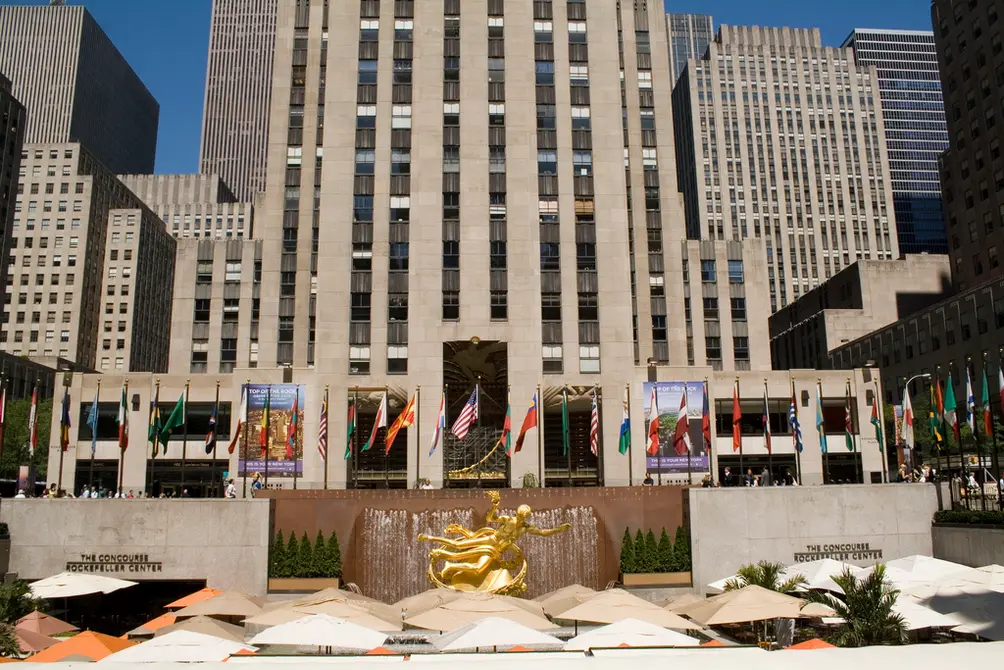 Flags around sunken plaza at Rockefeller Center. Image by David Hass via flickr
Flags around sunken plaza at Rockefeller Center. Image by David Hass via flickr
New York City is particularly blessed with two great con-FLAG-rations: the United Nations grounds and the sunken plaza at Rockefeller Center where the ever-burgeoning number of national flags are displayed daily.
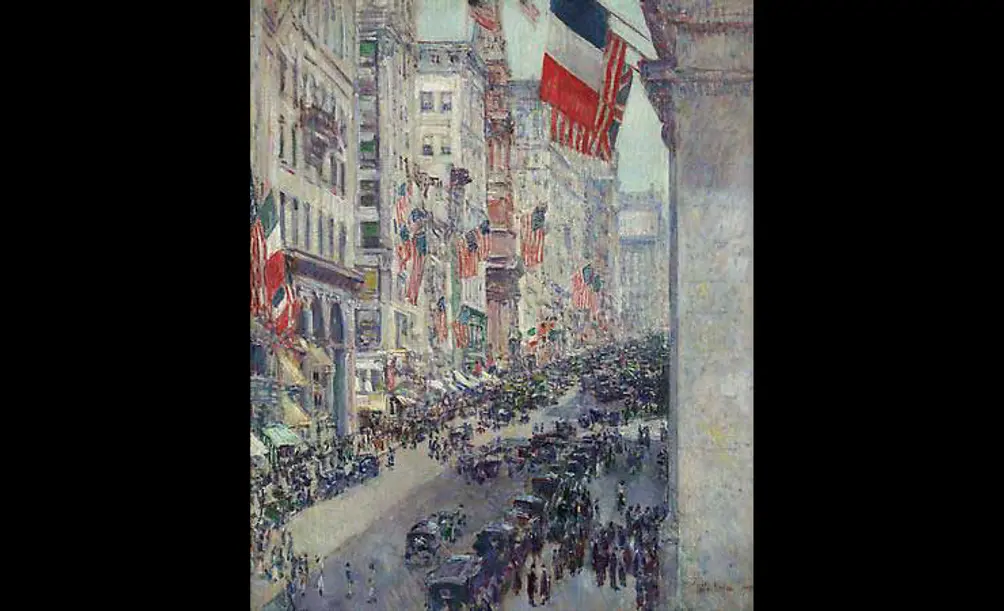 Childe Hassam's "Flags, Fifth Avenue"
Childe Hassam's "Flags, Fifth Avenue"
Perhaps the greatest paintings of the city were Childe Hassam's visions of flag-bestrewn Fifth Avenue on the Fourth of July and American Red Cross Day. From his perspective, gargantuan banners billowed the breadth of the avenue in a concatenation of great ceremony.
Lower Broadway's ticker-tape parades, of course, were titillating in their snowflake-like-blinding cascades but white-outs just do not have the dazzle of rippling banners of color. Ticker-tape parades are wonderful, joyful blizzards, of course, but may be wasted on self-centered, cell-phone hashtagers who have lost the knack of looking upwards.
Sometimes, a flag is simply attached to a pole on a rooftop perch. The Plaza and Peninsula hotels on Fifth Avenue, in fact, sport two each, but they are perhaps too high up for eye-level youngsters to appreciate.
Lower Broadway's ticker-tape parades, of course, were titillating in their snowflake-like-blinding cascades but white-outs just do not have the dazzle of rippling banners of color. Ticker-tape parades are wonderful, joyful blizzards, of course, but may be wasted on self-centered, cell-phone hashtagers who have lost the knack of looking upwards.
Sometimes, a flag is simply attached to a pole on a rooftop perch. The Plaza and Peninsula hotels on Fifth Avenue, in fact, sport two each, but they are perhaps too high up for eye-level youngsters to appreciate.
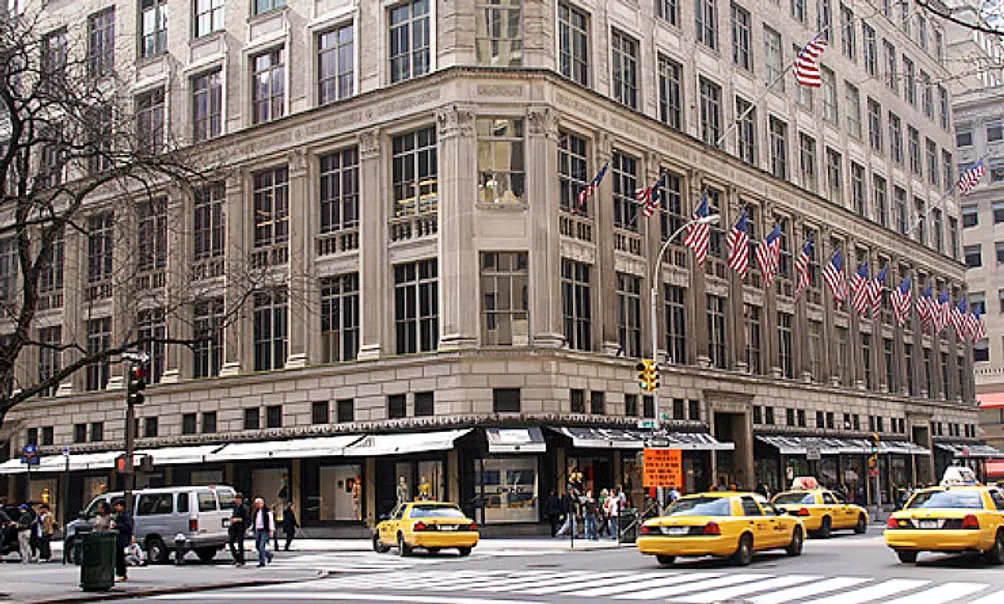 Saks 5th Avenue
Saks 5th Avenue
But more often the flagpole is employed in "outrigger" fashion on the sides of a building. Saks Fifth Avenue has a particularly nice block-long, line-up on its avenue frontage facing Rockefeller Center.
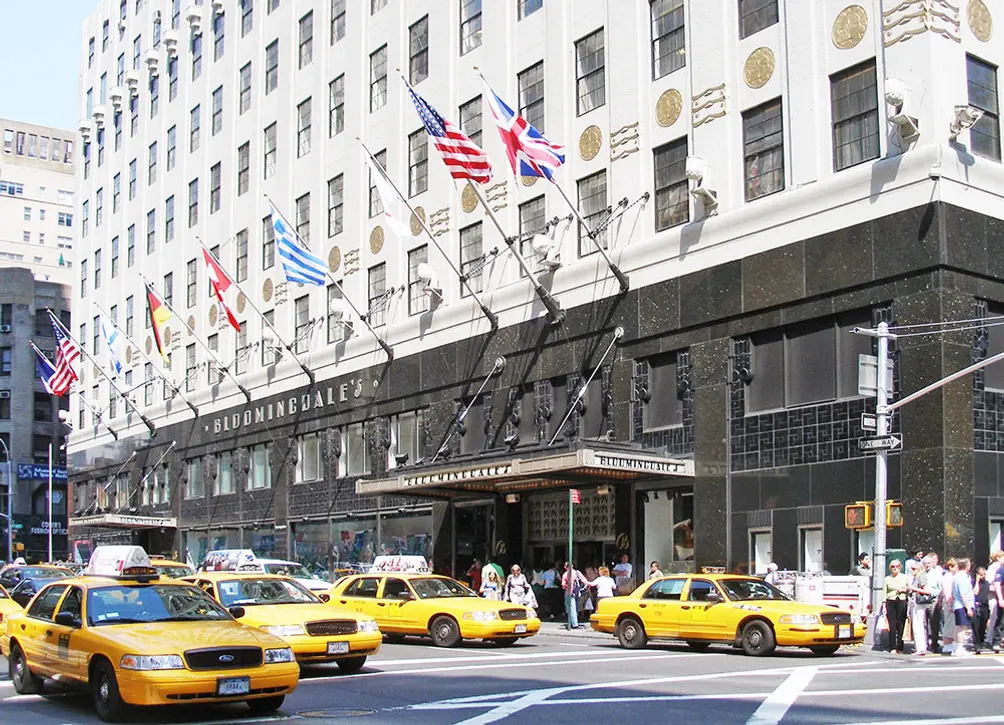 Bloomingdale's employs flags to highlight its nice Art Deco-style base
Bloomingdale's employs flags to highlight its nice Art Deco-style base
Bloomingdale’s followed suit and also has a very handsome array above its black, Art Deco-style base.
More common are the outrigger flag poles above hotel marquees. The Plaza Hotel, shown at the top of this article, has five above its spectacular marquee facing Fifth Avenue to denote not only its name, its operator, and its country, but also the nationality of its two most distinguished guests at any given time.
Flags, of course, are used in a great variety of ways.
Navies have their semaphore flags to silently communicate between ships at sea.
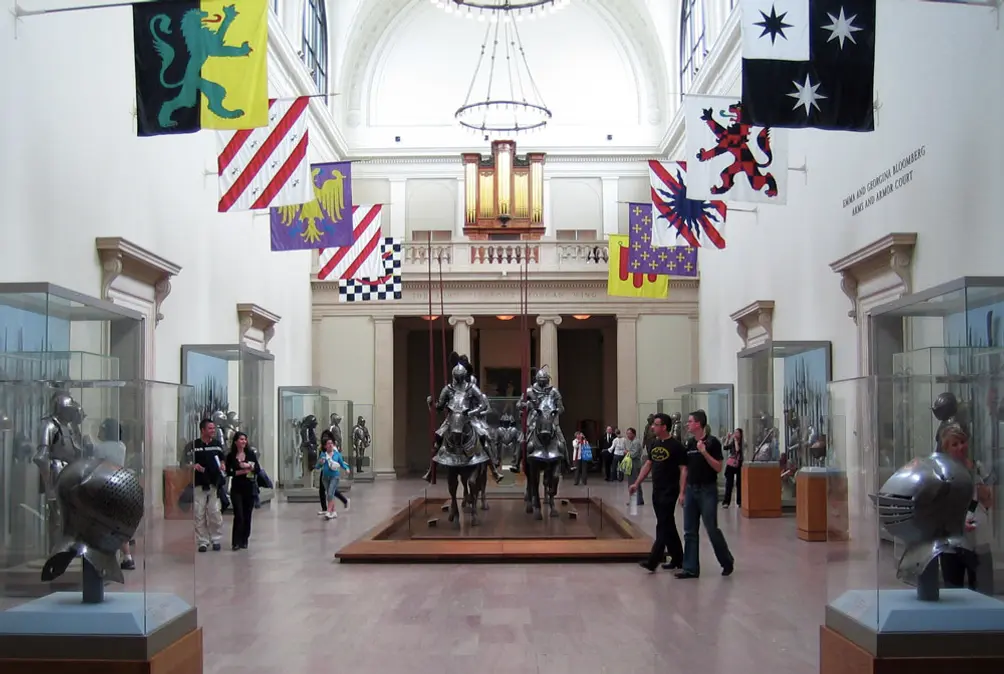 Armor Hall with heraldic flags at the Metropolitan Museum of Art
Armor Hall with heraldic flags at the Metropolitan Museum of Art
Armies have their flags to distinguish their platoons and regiments and divisions just as in medieval times lords had their heraldic "arms" to proclaim their territoriality.
The study of flags is known as vexillogoy from the Latin "vexillum," meaning flag or banner, and possibly "vellum." Tribal leaders would often wear ceremonial headdresses or carry ceremonial staffs and over time the heavy staffs of the standard-bearers of the Roman legions gave way to lighter cloth banners often using silk that had been fashioned originally in China.
Here we are! Come 'n get it!
At once proud and defiant, flags have honor.
Rally around! Hold up High!
Face it. Flags are fashionable!
From the great twirling at the Palio in Italy to the coffin-draping at Arlington to the flagpoles at 18th holes, flags run the gamut of colors, designs and emotions.
According to some sources, Denmark's flag, the Dannebrog, is the oldest state flag still in use and inspired the cross design of numerous Scandinavian countries.
The Union Jack of England is reportedly the most commonly used and probably the most abstract. The oldest tricolor belongs to The Netherlands, dating back to 1572 when it was orange, white and blue, although it would change its colors in a few years to red, white and blue.
The crescent on the flag of Turkey would be reflected in the flags of other Muslim nations such as Algeria, Malaysia, Pakistan and Tunisia and the Pan-Arab colors of green, white, red and black come from the flag of the "Great Arab Revolt" and can be found on the flags of Syria, Egypt, Iraq, Palestine, the United Arab Emirates, Jordan, Sudan, Western Sahara and Kuwait.
When a national flag is flown upside down it signifies distress, but in the Philippines it signifies a state of war, which of course is also distress. Maritime custom recommends that ships fly their ensign and the flag of the nation they are visiting and, according to a Wikepedia entry, "To fly one's ensign alone in foreign waters, a foreign port or in the face of a foreign warship traditionally indicates a willingness to fight, with cannon, for the right to do so."
Perhaps it's time for New York City to insist that buildings adopt the maritime custom of having signal flags for numerals and letters of the alphabet and to display their addresses with them. Perhaps then Mayor de Blasio could sponsor an international festival for artists. Indeed, perhaps he could insist that all bicycles and cars display their license numbers thusly.
The study of flags is known as vexillogoy from the Latin "vexillum," meaning flag or banner, and possibly "vellum." Tribal leaders would often wear ceremonial headdresses or carry ceremonial staffs and over time the heavy staffs of the standard-bearers of the Roman legions gave way to lighter cloth banners often using silk that had been fashioned originally in China.
Here we are! Come 'n get it!
At once proud and defiant, flags have honor.
Rally around! Hold up High!
Face it. Flags are fashionable!
From the great twirling at the Palio in Italy to the coffin-draping at Arlington to the flagpoles at 18th holes, flags run the gamut of colors, designs and emotions.
According to some sources, Denmark's flag, the Dannebrog, is the oldest state flag still in use and inspired the cross design of numerous Scandinavian countries.
The Union Jack of England is reportedly the most commonly used and probably the most abstract. The oldest tricolor belongs to The Netherlands, dating back to 1572 when it was orange, white and blue, although it would change its colors in a few years to red, white and blue.
The crescent on the flag of Turkey would be reflected in the flags of other Muslim nations such as Algeria, Malaysia, Pakistan and Tunisia and the Pan-Arab colors of green, white, red and black come from the flag of the "Great Arab Revolt" and can be found on the flags of Syria, Egypt, Iraq, Palestine, the United Arab Emirates, Jordan, Sudan, Western Sahara and Kuwait.
When a national flag is flown upside down it signifies distress, but in the Philippines it signifies a state of war, which of course is also distress. Maritime custom recommends that ships fly their ensign and the flag of the nation they are visiting and, according to a Wikepedia entry, "To fly one's ensign alone in foreign waters, a foreign port or in the face of a foreign warship traditionally indicates a willingness to fight, with cannon, for the right to do so."
Perhaps it's time for New York City to insist that buildings adopt the maritime custom of having signal flags for numerals and letters of the alphabet and to display their addresses with them. Perhaps then Mayor de Blasio could sponsor an international festival for artists. Indeed, perhaps he could insist that all bicycles and cars display their license numbers thusly.
After 9/11/01, New York City did not raise the white flag of surrender but instead blossomed with the nation's "Old Glory" and "Stars and Stripes" on almost every building and in some cases many on one building as can be seen in this photograph of a Times Square building shortly after the terrorist attacks.
Surprisingly, subsequent anniversaries of the terrorist attack have not evoked as universal a display.
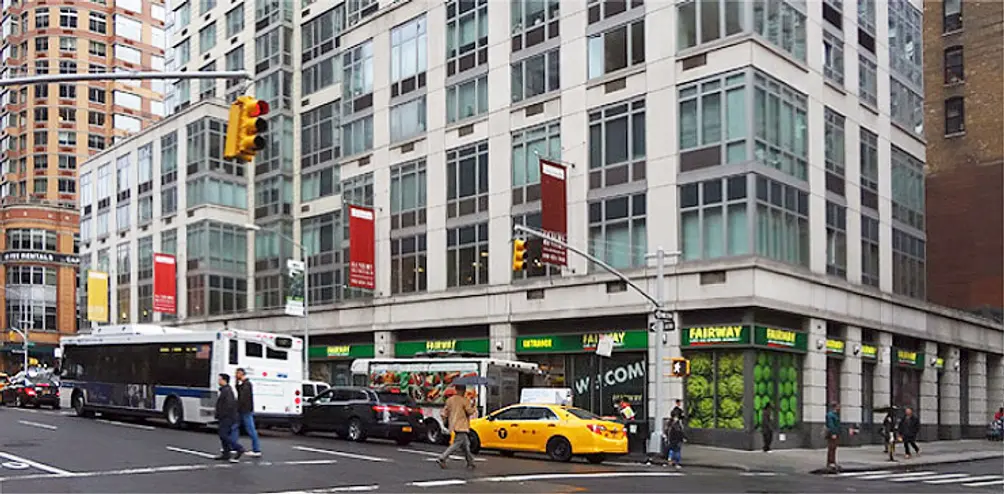 Hanging Banners advertising Chelsea Landmark apartment building on 6th Avenue
Hanging Banners advertising Chelsea Landmark apartment building on 6th Avenue
National flags increasingly are getting competition from commercial ones. The Chelsea Landmark apartment building on the east side of Sixth Avenue between 25th and 26th streets has four large rectangular banners heralding availability in the building and they compete with one street-post banner on the same block, as shown in the above photograph.
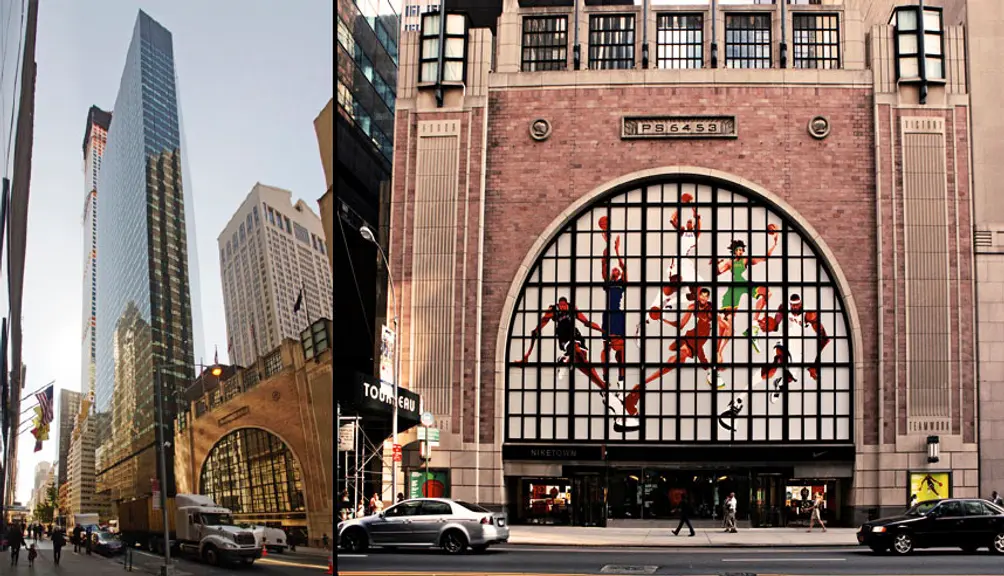 Flags atop Nike store on 57th Street east of Fifth Avenue
Flags atop Nike store on 57th Street east of Fifth Avenue
The Nike store on 57th Street between Fifth and Madison avenues sports six rooftop flags, probably a record.
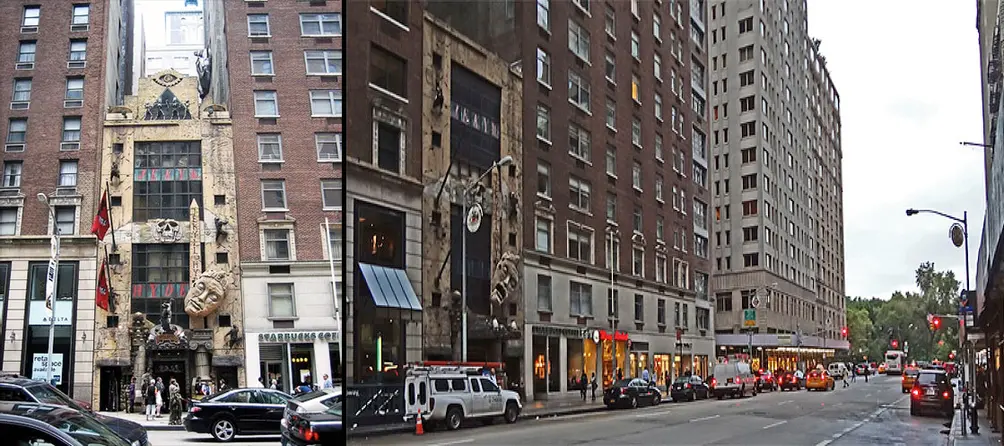 Jekyll & Hyde Club, Sixth Avenue between 57th & 58th Streets, with one of Sixth Avenue's last circular national enamel shields, representing Chile, on nearby lamppost. There are three other plaques in this picture and one on the southwest corner at 57th Street
Jekyll & Hyde Club, Sixth Avenue between 57th & 58th Streets, with one of Sixth Avenue's last circular national enamel shields, representing Chile, on nearby lamppost. There are three other plaques in this picture and one on the southwest corner at 57th Street
The very amusing Jekyll & Hyde Club on the Avenue of the Americas between 57th and 58th Streets, now closed, sports two outrigger flags along with various skeletons, historic monuments and a crashed airplane, now missing (presumably in action), but most importantly it stands guard over one of the avenue's last surviving circular enamel plaques honoring the nations of the Americas after which Sixth Avenue is now named. In this case, it is Chile. Most of the plaques, sadly have been removed and while largely stationery they added color and pageantry to the avenue.
It would be nice is some worldly philanthropist would recreate the plaques and campaign to rehang them.
It would be nice is some worldly philanthropist would recreate the plaques and campaign to rehang them.

Architecture Critic
Carter Horsley
Since 1997, Carter B. Horsley has been the editorial director of CityRealty. He began his journalistic career at The New York Times in 1961 where he spent 26 years as a reporter specializing in real estate & architectural news. In 1987, he became the architecture critic and real estate editor of The New York Post.

 6sqft delivers the latest on real estate, architecture, and design, straight from New York City.
6sqft delivers the latest on real estate, architecture, and design, straight from New York City.
